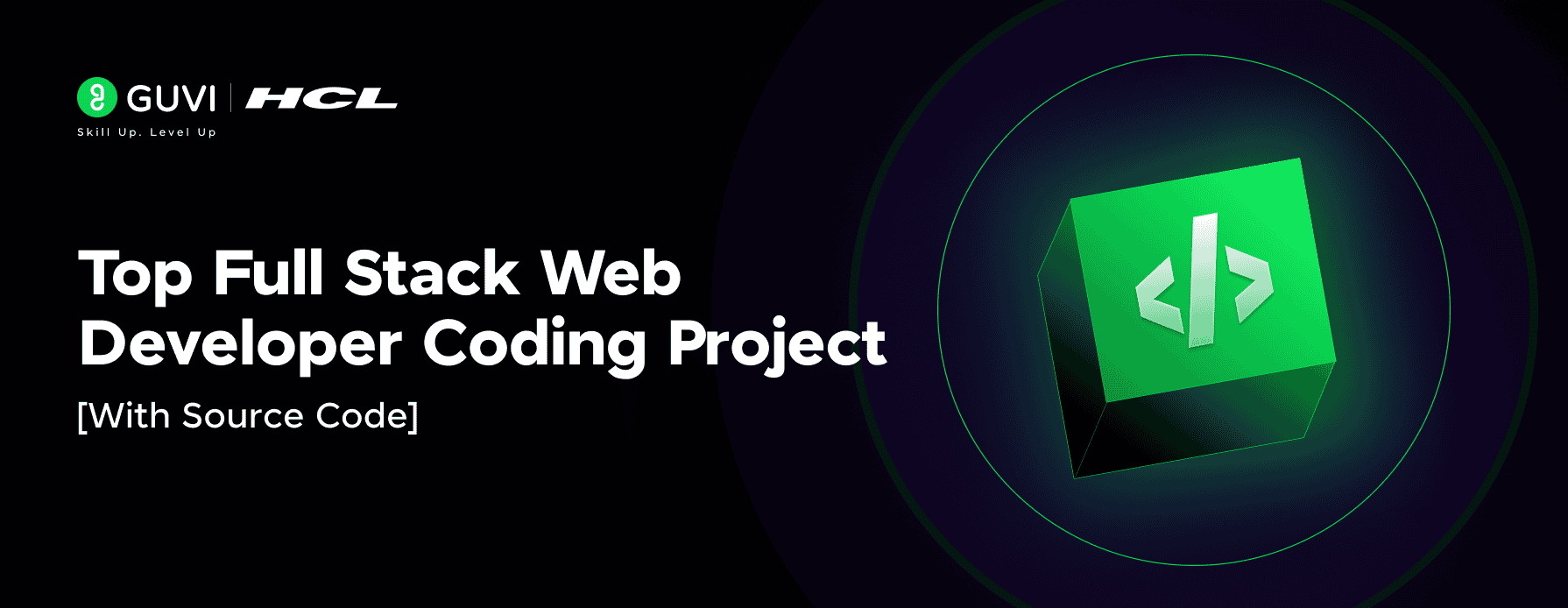
Top Full Stack Web Developer Coding Projects in 2025 [With Source Code]
Oct 13, 2025 9 Min Read 18001 Views
(Last Updated)
Are you not getting hired in your desired full-stack role even after clearing multiple technical and personality rounds? Well, it’s probably your project portfolio. In today’s highly competitive tech world, full stack web developer coding projects play a significant role as companies look for versatile developers who can manage both front-end and back-end development.
Companies value full-stack developers because they improve efficiency and bring flexibility to development processes. What kind of projects do these companies look for in your portfolio?
To address this question, I’ve drafted this article featuring 10 practical full-stack web developer coding projects that will strengthen your portfolio. You’ll find detailed explanations, source code, and learning outcomes that make concepts easier to grasp. These projects will effectively showcase your full-stack development skills, regardless of whether you’re starting or have years of experience.
Table of contents
- Top 10 Full Stack Web Developer Coding Projects
- 1) Personal Portfolio Website
- 2) Task Management Application
- 3) E-commerce Store with Payment Integration
- 4) Real-time Chat Application
- 5) Social Media Platform
- 6) Blog Platform with Content Management
- 7) Recipe Sharing Application
- 8) Job Board Portal
- 9) Healthcare Appointment System
- 10) Online Learning Platform
- Concluding Thoughts…
- FAQs
- Q1. What are some essential full-stack web developer projects for 2025?
- Q2. Which programming languages and frameworks are recommended for full-stack development in 2025?
- Q3. How can I showcase my full-stack development skills to potential employers?
- Q4. What are some advanced features I can add to my full-stack projects?
Top 10 Full Stack Web Developer Coding Projects
A strong portfolio showcases your full-stack development skills effectively. These projects will help you master the technologies that matter in 2025’s digital world and build a diverse portfolio. Each project has unique challenges that strengthen different parts of your development skills, from frontend design to complex backend features. Let’s begin!
1) Personal Portfolio Website
A personal portfolio website acts as your digital business card and is the lifeblood of your full-stack development trip. A well-crafted portfolio does more than a simple landing page – it shows your technical abilities and creative vision in one detailed package.
![Top Full Stack Web Developer Coding Projects in 2025 [With Source Code] 1 Personal Portfolio Website](https://www.guvi.in/blog/wp-content/uploads/2025/04/Personal-Portfolio-Website-1200x628.png)
Your portfolio website demonstrates your coding skills live. This lets potential employers or clients experience your work firsthand. On top of that, it gives valuable insight into your personality and work ethic while acting as a central hub for your professional achievements.
Project Duration–2 weeks (for a basic version), 3–4 weeks (for an advanced dynamic version with backend integration)
Key Features:
- Homepage with a short introduction and professional banner
- About section with resume download
- Project showcase with GitHub/live demo links
- Skills and technologies section (icons or text-based)
- Contact form (connected to backend or third-party APIs like EmailJS or Formspree)
- Blog or testimonials section (optional)
- Responsive design for desktop, tablet, and mobile views
Tech Stack:
- Frontend: HTML5, CSS3, JavaScript (Vanilla or frameworks like React or Vue)
- Backend: Node.js with Express.js or Python with Django/Flask
- Database: MongoDB or Firebase (optional for contact forms or blog)
- Version Control: Git and GitHub
- Deployment: GitHub Pages, Netlify, or Vercel
Learning Outcomes:
- Implementing responsive layouts using CSS Grid or Flexbox
- Routing in single-page applications (SPA) if using React/Vue
- Form validation and handling user inputs
- Integrating email services or setting up a basic backend for form submissions
- Optimizing performance, accessibility, and SEO for portfolio visibility
Source Code GitHub Link to Project: You can find a complete starter template for your portfolio website on GitHub, Personal Portfolio Website project.
2) Task Management Application
Task management apps are practical solutions that help people stay productive. Full-stack developers can use these projects to show their core development skills. The project combines UI design with backend data storage and makes a great portfolio piece. You can demonstrate your skills by creating software that solves real-life problems.
![Top Full Stack Web Developer Coding Projects in 2025 [With Source Code] 2 Task Management Application](https://www.guvi.in/blog/wp-content/uploads/2025/04/Task-Management-Application-1200x628.png)
A task management application lets users organize their workload through task creation, scheduling, and progress tracking. Users can reduce stress by organizing tasks with clear priorities. Task management goes beyond simple to-do lists. It needs user authentication, task categorization, and data storage.
Project Duration: 3 to 4 weeks (can vary based on feature complexity and integrations)
Key Features:
- User registration and login system
- Create, read, update, and delete (CRUD) tasks
- Task categories (e.g., Work, Personal, Urgent)
- Deadline assignment and due date reminders
- Task status labels (To Do, In Progress, Done)
Tech Stack:
- Frontend: React.js or Vue.js
- Backend: Node.js with Express.js
- Database: MongoDB or PostgreSQL
- Authentication: JWT or OAuth2
- State Management: Redux or Context API
- Styling: Tailwind CSS or Bootstrap
- Hosting: Vercel, Netlify (Frontend) + Render or Heroku (Backend)
Learning Outcomes:
- Authentication Implementation: Become skilled at secure user registration and login flows
- CRUD Operations: Creating, reading, updating, and deleting data through API endpoints
- State Management: Handling application state across components
- Form Validation: Implementing client and server-side validation
- Data Persistence: Working with databases to store and retrieve information
- API Development: Building RESTful services for frontend-backend communication
Source Code GitHub Link to Project: A detailed task management application template is available on the Task Management Application project.
3) E-commerce Store with Payment Integration
Building an e-commerce store with payment integration adds significant value to your full-stack project portfolio. Retail e-commerce sales worldwide have reached USD 5.80 trillion. This makes such projects highly relevant to developers who want to showcase their business application skills.
![Top Full Stack Web Developer Coding Projects in 2025 [With Source Code] 3 E commerce Store with Payment Integration](https://www.guvi.in/blog/wp-content/uploads/2025/04/E-commerce-Store-with-Payment-Integration-1200x628.png)
The project pushes you to create a complete online shopping experience with secure payment processing. These skills are highly valued by employers worldwide. The scope includes customer-facing interfaces and complex backend systems that process sensitive transaction data.
Project Duration: 4–6 weeks (including development, testing, and deployment)
Key Features:
- Product Catalog: Searchable listings with categories, filters, and sorting options
- Shopping Cart System: Add, remove, and update quantities with total calculation
- User Authentication: Registration, login, and profile management
- Payment Gateway Integration: Secure processing of multiple payment methods
- Order Management: Order creation, history, and status tracking
Tech Stack:
- Frontend: React.js or Next.js
- Backend: Node.js with Express.js
- Database: MongoDB or PostgreSQL
- Authentication: JWT or OAuth
- Payment Integration: Stripe, Razorpay, or PayPal SDKs
- Deployment: Vercel, Netlify (frontend), Render, or Heroku (backend)
Learning Outcomes:
- Payment Processing: Implementing secure payment gateways like Stripe, PayPal, or Shopify Payments
- State Management: Handling complex application states across components
- API Integration: Working with external services and third-party APIs
- Security Implementation: Protecting sensitive customer and payment data
- Database Design: Creating schemas for products, orders, and user information
Source Code GitHub Link to Project: You can find a complete starter template for your e-commerce store with payment integration on the GitHub E-commerce Store project.
4) Real-time Chat Application
Chat applications now play a vital role in modern web development. Users send over 41 million messages every minute through messaging apps worldwide. Building a chat application as a full-stack project gives you a chance to become skilled at WebSocket communication. You’ll learn real-life data handling techniques that companies value highly in today’s digital world.
![Top Full Stack Web Developer Coding Projects in 2025 [With Source Code] 4 Real time Chat Application](https://www.guvi.in/blog/wp-content/uploads/2025/04/Real-time-Chat-Application-1200x628.png)
A live chat application lets users exchange messages instantly without refreshing the page. This creates a smooth conversation flow. The project challenges you to build frontend interfaces and backend systems that keep connections stable. These skills show you know how to manage complex data flows.
Project Duration: 3 to 4 weeks (including development, testing, and deployment)
Key Features:
- One-on-one and Group Messaging: Support for both private conversations and group chats
- Message Storage and History: You can retrieve previous conversations
- Audio and Video Calls: Integration of voice and video communication
- File Sharing Capabilities: Support for images, videos, and document transfers
- Message Editing/Deleting: Users can modify or remove sent messages
- Push Notifications: Alerts for new messages when users aren’t active
Tech Stack:
- Frontend: React.js or Vue.js
- Backend: Node.js with Express.js
- Database: MongoDB or PostgreSQL
- Real-Time Communication: Socket.IO or WebSocket API
- Authentication: JSON Web Tokens (JWT), bcrypt.js
- Deployment: Render, Vercel, or AWS EC2
Learning Outcomes:
- Real-time Protocol Implementation: Understanding WebSockets and Socket.IO functionality
- State Synchronization: Keeping states consistent across multiple connected clients
- Security Implementation: User authentication and message encryption
- Scalability Challenges: Managing multiple concurrent connections effectively
- Error Handling: Managing connection drops and reconnection strategies
- Data Persistence: Storing messages for offline users
Source Code GitHub Link to Project: You can find a complete starter template for your real-time chat application on GitHub at the Real-Time Chat Application project.
5) Social Media Platform
Social media platforms have grown beyond simple networking tools into essential parts of our daily digital lives. These platforms now act as spaces where users connect, share resources, and join meaningful discussions. Building a social media platform as a full-stack project gives you great opportunities to become skilled at complex user interactions and immediate content delivery systems.
![Top Full Stack Web Developer Coding Projects in 2025 [With Source Code] 5 Social Media Platform](https://www.guvi.in/blog/wp-content/uploads/2025/04/Social-Media-Platform-1200x628.png)
A social media platform project pushes you to build features that make user involvement easier while keeping data secure across thousands of interactions. This project helps you learn how to handle user-generated content – a skill that’s valuable in today’s developer market.
Project Duration: 4 to 6 weeks (depending on the feature set and depth of implementation)
Key Features:
- User-Friendly Profiles: Customizable profiles with personal information and activity history
- Content Creation and Sharing: Tools to post text, images, videos, and other media types
- Immediate News Feed: Dynamic content stream with personalization algorithms
- Friend/Connection System: Network building through follows, connections, or friend requests
- Interactive Elements: Likes, comments, and reactions to track engagement
- Search Functionality: Strong search capabilities to find users, content, and hashtags
Tech Stack:
- Frontend: React.js or Next.js, Tailwind CSS or Material UI
- Backend: Node.js with Express.js
- Database: MongoDB (NoSQL) or PostgreSQL (SQL)
- Authentication: JWT (JSON Web Tokens), OAuth (for social login)
- Real-time Features: Socket.io for messaging and notifications
- Deployment: Vercel (Frontend) + Render or Railway (Backend and DB)
- Optional Tools: Cloudinary for image storage, Redux or Context API for state management
Learning Outcomes:
- Immediate Data Management: Handle live updates across multiple users at once
- Content Delivery Optimization: Serve large volumes of user-generated content efficiently
- Complex Database Relationships: Manage interconnected user networks and content
- Security Implementation: Protect user data and prevent common vulnerabilities
- Adaptable Architecture Design: Build systems that grow with increasing user bases
- Search Algorithm Development: Create efficient content discovery mechanisms
Source Code GitHub Link to Project: You can find a complete starter template for your real-time chat application on GitHub at the Social Media Platform Project.
Would you like to start learning React but aren’t sure about online courses yet? Well then, our React e-book will be the perfect place for you to begin! Start reading now.
6) Blog Platform with Content Management
Building a blog platform with a content management system lets you create and publish content without technical hurdles. The year 2025 brings opportunities to develop systems that handle everything from content creation to distribution as a full-stack project.
![Top Full Stack Web Developer Coding Projects in 2025 [With Source Code] 6 Blog Platform with Content Management](https://www.guvi.in/blog/wp-content/uploads/2025/04/Blog-Platform-with-Content-Management-1200x628.png)
Content management systems help non-technical users manage their websites easily. Look at WordPress – it powers 43% of all websites on the internet, showing its massive impact on bloggers and content creators. Your blog platform project will teach you vital skills in managing user content and publishing workflows.
Project Duration: 3 to 5 weeks (based on complexity and feature set)
Key Features:
- Rich Text Editor: WYSIWYG editing with formatting tools and media embedding
- User Role Management: Different permission levels (admin, editor, author, reader)
- Media Library: Uploading, storing, and organizing images and other media
- Comment System: Interactive discussions with moderation capabilities
- Categories and Tags: Content organization and classification
Tech Stack:
- Frontend: React.js with Redux or Next.js
- Backend: Node.js with Express.js
- Database: MongoDB or PostgreSQL
- Authentication: JSON Web Tokens (JWT), bcrypt
- Rich Text Editor: Quill.js or TinyMCE
- Image Storage: Cloudinary or AWS S3
- Deployment: Vercel for frontend, Render or Heroku for backend
Learning Outcomes:
- Content Management Principles: Understanding information architecture and workflows
- Database Design: Creating schemas for articles, media, and user relationships
- Authentication Systems: Implementing user roles and permissions
- Rich Text Editing: Integrating complex editing interfaces
- Media Handling: Processing, storing, and serving images and videos
- SEO Optimization: Implementing search engine-friendly structures
Source Code GitHub Link to Project: You can find a complete starter template for your real-time chat application on GitHub at the Blog Platform project.
7) Recipe Sharing Application
Recipe sharing apps have evolved faster into complete culinary hubs. Food enthusiasts connect and find dishes from around the world. Research shows these platforms let users create individual-specific feeds with recipes that match their tastes and priorities. They work like specialized social networks for cooking enthusiasts.
![Top Full Stack Web Developer Coding Projects in 2025 [With Source Code] 7 Recipe Sharing Application](https://www.guvi.in/blog/wp-content/uploads/2025/04/Recipe-Sharing-Application-1200x628.png)
These recipe-sharing platforms attract both novice home cooks and professional chefs. They promote genuine connections between users who share similar food interests. Users build strong communities around their shared culinary passions.
Project Duration: 3 to 5 weeks (based on feature complexity and deployment)
Key Features:
- User Authentication and Profiles: A Secure registration system lets users customize their accounts
- Recipe CRUD Operations: Complete functionality to create, read, update, and delete recipes with images and instructions
- Advanced Search and Filters: Search recipes by ingredients, cuisine type, dietary restrictions, or cooking time
- Rating and Comment System: Users review recipes and share cooking tips
- Social Interaction: Follow other users, send messages, and track activity feeds
Tech Stack:
- Frontend: React.js or Next.js for dynamic rendering and component-based UI
- Backend: Node.js with Express.js for API creation and server-side logic
- Database: MongoDB or PostgreSQL for storing user accounts and recipe data
- Authentication: JWT or OAuth for secure login/signup
- Storage: Cloudinary or Firebase Storage for handling image uploads
- Deployment: Vercel or Heroku for live project hosting
- Additional Tools: Redux or Context API for state management (if using React)
Learning Outcomes:
- Schema Design: Create flexible database models for recipes, users, and interactions
- Search Algorithm Implementation: Build effective recipe discovery systems
- Media Processing: Handle image uploads, storage, and optimization
- User Experience Design: Create accessible interfaces for recipe creation and browsing
- Social Feature Development: Add following, sharing, and interaction systems
Source Code GitHub Link to Project: You can find a complete starter template for your real-time chat application on GitHub at the Recipe Sharing Application project.
8) Job Board Portal
Job board portals serve as digital marketplaces where employers and job seekers meet to make hiring easier. A full-stack job board project adds value to your portfolio and shows you know how to build real-life solutions. This type of project proves especially useful when you have to implement multiple user roles and complex filtering systems.
![Top Full Stack Web Developer Coding Projects in 2025 [With Source Code] 8 Job Board Portal](https://www.guvi.in/blog/wp-content/uploads/2025/04/Job-Board-Portal-1200x628.png)
Successful job boards need to work for both employers who post jobs and candidates looking for opportunities. A well-laid-out job portal gives all users easy access through user-friendly tools that make recruitment simple from start to finish.
Project Duration: 2-3 weeks ( based on the complexity and features)
Key Features:
- Advanced Search and Filtering: Tools for refining job searches by category, location, salary range, and experience level
- Dual User Authentication: Separate registration systems for employers and job seekers with appropriate dashboards
- Application Tracking System: Kanban-style board for categorizing applications by hiring status
- Job Alerts and Notifications: Automated emails when new jobs match saved criteria
- Resume Parsing: Auto-fill forms from uploaded resumes using AI technology
- Application Management: Tools for submitting, tracking, and managing job applications
Tech Stack:
- Frontend: React.js or Next.js for dynamic rendering and component-based UI
- Backend: Node.js with Express.js for API creation and server-side logic
- Database: MongoDB for storing job listings, user profiles, and application data
- Authentication: JWT or OAuth for secure login/signup and user management
- Storage: Cloudinary or Firebase Storage for handling profile pictures and resume uploads
- Deployment: Vercel or Heroku for live project hosting
- Additional Tools: Redux or Context API for managing state across the application (especially useful for React)
Learning Outcomes:
- Multi-role System Design: Creating tailored experiences for different user types
- Complex Search Implementation: Building effective filtering and matching algorithms
- Data Relationship Management: Handling connections between jobs, applicants, and employers
- Subscription Model Development: Implementing recurring billing and feature access control
- Privacy and Security: Protecting sensitive user information and application data
Source Code GitHub Link to Project: You can find a complete starter template for your real-time chat application on GitHub at Job Board Portal project.
9) Healthcare Appointment System
Healthcare appointment systems are revolutionizing how patients book medical visits through digital solutions that simplify scheduling. Recent studies reveal that 95% of patients would rather book their doctor appointments online. This shows how much patients just need these applications. A user-friendly healthcare scheduling platform eliminates phone tag and improves the patient’s experience throughout their medical care.
![Top Full Stack Web Developer Coding Projects in 2025 [With Source Code] 9 Healthcare Appointment System](https://www.guvi.in/blog/wp-content/uploads/2025/04/Healthcare-Appointment-System-1200x628.png)
Building a healthcare appointment system lets you blend technical expertise with specific knowledge of medical processes. The project requires you to understand patient requirements and provider limitations while following strict healthcare regulations.
Project Duration: 4 to 6 weeks (depending on the complexity and additional features such as notifications, payment gateway, etc.)
Key Features:
- Patient Self-Scheduling: Book appointments online without staff help
- Automated Reminders: SMS/email alerts reduce missed appointments
- Provider Calendar Integration: Two-way calendar sync prevents double-booking
- Role-Based Access: Different interfaces for patients, doctors, and administrators
- Time Zone Management: Auto-converts times for patients across locations
- Waiting List Automation: Notifies waitlisted patients about canceled slots
Tech Stack:
- Frontend: React.js or Next.js for dynamic UI and component-based rendering.
- Backend: Node.js with Express.js for API creation and server-side logic.
- Database: MongoDB or PostgreSQL for storing user and appointment data.
- Authentication: JWT or OAuth for secure login and user authentication.
- Storage: Cloudinary or Firebase Storage for image and document storage.
- Deployment: Vercel or Heroku for hosting the application.
- Additional Tools: Redux or Context API for state management.
Learning Outcomes:
- Healthcare Data Security: Build HIPAA-compliant protection for sensitive data
- Scheduling Algorithms: Design a conflict-free booking with provider rules
- Calendar API Integration: Connect with external calendar services
- Notification Systems: Create automated reminder workflows
- Domain-Specific Design: Build interfaces for healthcare settings
Source Code GitHub Link to Project: You can find a complete starter template for your real-time chat application on GitHub at the Healthcare Appointment System project.
10) Online Learning Platform
Online learning platforms stand among the most effective full-stack projects to build. These platforms create dynamic educational environments where knowledge transfer happens without geographical boundaries. Studies show that digital learning platforms substantially affect students’ motivation and knowledge development. This makes the project technically challenging and socially valuable.
The platform works as a complete system to aid content delivery, help users participate, and track performance. These skills remain highly sought after in full-stack developers.
![Top Full Stack Web Developer Coding Projects in 2025 [With Source Code] 10 Online Learning Platform](https://www.guvi.in/blog/wp-content/uploads/2025/04/Online-Learning-Platform-1200x628.png)
Project Duration: 2 to 4 weeks (depending on the complexity of the platform, the number of features, and your familiarity with the tech stack).
Key Features:
- User-friendly Interface: Accessible navigation with a clean, responsive design on a variety of devices
- Content Management System: Tools to upload, organize, and update educational materials
- Interactive Learning Elements: Quizzes, assessments, and gamification components
- Customized Learning Paths: Adaptive content based on learner performance and priorities
- Video Integration: Support for educational videos with interactive elements
Tech Stack:
- Frontend: React.js or Next.js for building dynamic, component-based UIs, Tailwind CSS for fast, responsive design.
- Backend: Node.js with Express.js for creating the API and server-side logic.
- Database: MongoDB for unstructured data storage, PostgreSQL for structured data relationships.
- Authentication: JWT or OAuth for secure login and user sessions.
- Storage: Cloudinary or Firebase Storage for handling media files (e.g., course videos, PDFs).
- Deployment: Vercel or Heroku for hosting the project.
- State Management: Redux or Context API for managing app state.
Learning Outcomes:
- Educational UX Design: Creating interfaces optimized for learning experiences
- Content Delivery Systems: Building reliable infrastructure for educational resources
- Assessment Implementation: Developing testing mechanisms and feedback loops
- Learning Analytics: Creating data visualization for educational progress
- Adaptive Systems: Implementing algorithms that customize content delivery
Source Code GitHub Link to Project: You can find a complete starter template for your real-time chat application on GitHub at the Online Learning Platform project.
If you’re looking to master Full Stack Development and build an impressive project portfolio, the HCL GUVI Full Stack Development Course is your perfect starting point. This comprehensive course equips you with in-depth skills across both front-end and back-end technologies, enabling you to create stunning and dynamic projects like the ones in this article that stand out to employers in 2025.
Concluding Thoughts…
These 10 full-stack projects are a great way to get development experience and build a compelling portfolio. Each project builds specific technical skills that employers value – from user authentication to payment processing.
Building these projects will help you become skilled at the technologies used in modern web development. Make sure to pick projects that line up with your interests and career goals. Note that employers value clean code, proper documentation, and thoughtful user experiences in portfolio projects.
FAQs
Q1. What are some essential full-stack web developer projects for 2025?
Some essential full-stack projects for 2025 include a personal portfolio website, a task management application, an e-commerce store with payment integration, a real-time chat application, and a social media platform. These projects cover a wide range of skills and technologies that are in high demand.
Q2. Which programming languages and frameworks are recommended for full-stack development in 2025?
For full-stack development in 2025, popular choices include JavaScript with React or Angular for the frontend, and Node.js with Express for the backend. Other recommended technologies are MongoDB or PostgreSQL for databases, and frameworks like Next.js or Django, depending on your preferred language.
Q3. How can I showcase my full-stack development skills to potential employers?
You can showcase your skills by building a diverse portfolio of projects that demonstrate your abilities in both frontend and backend development. Include projects like a personal website, e-commerce platform, or real-time applications. Make sure to highlight your problem-solving skills and ability to work with various technologies.
Q4. What are some advanced features I can add to my full-stack projects?
Advanced features you can add include real-time updates using WebSockets, implementing AI-powered recommendations, integrating third-party APIs, adding voice or image recognition capabilities, or implementing blockchain technology for secure transactions.


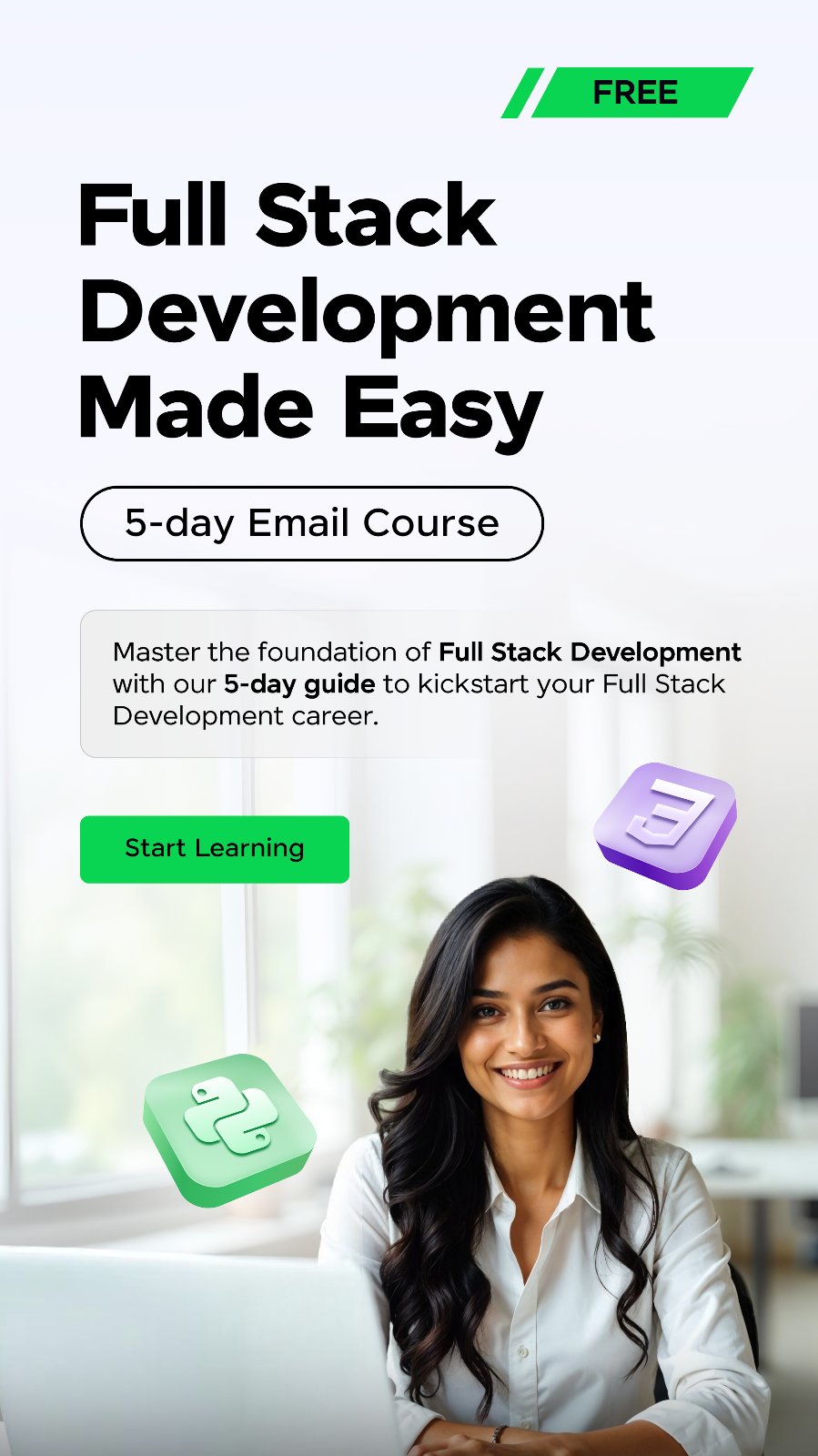
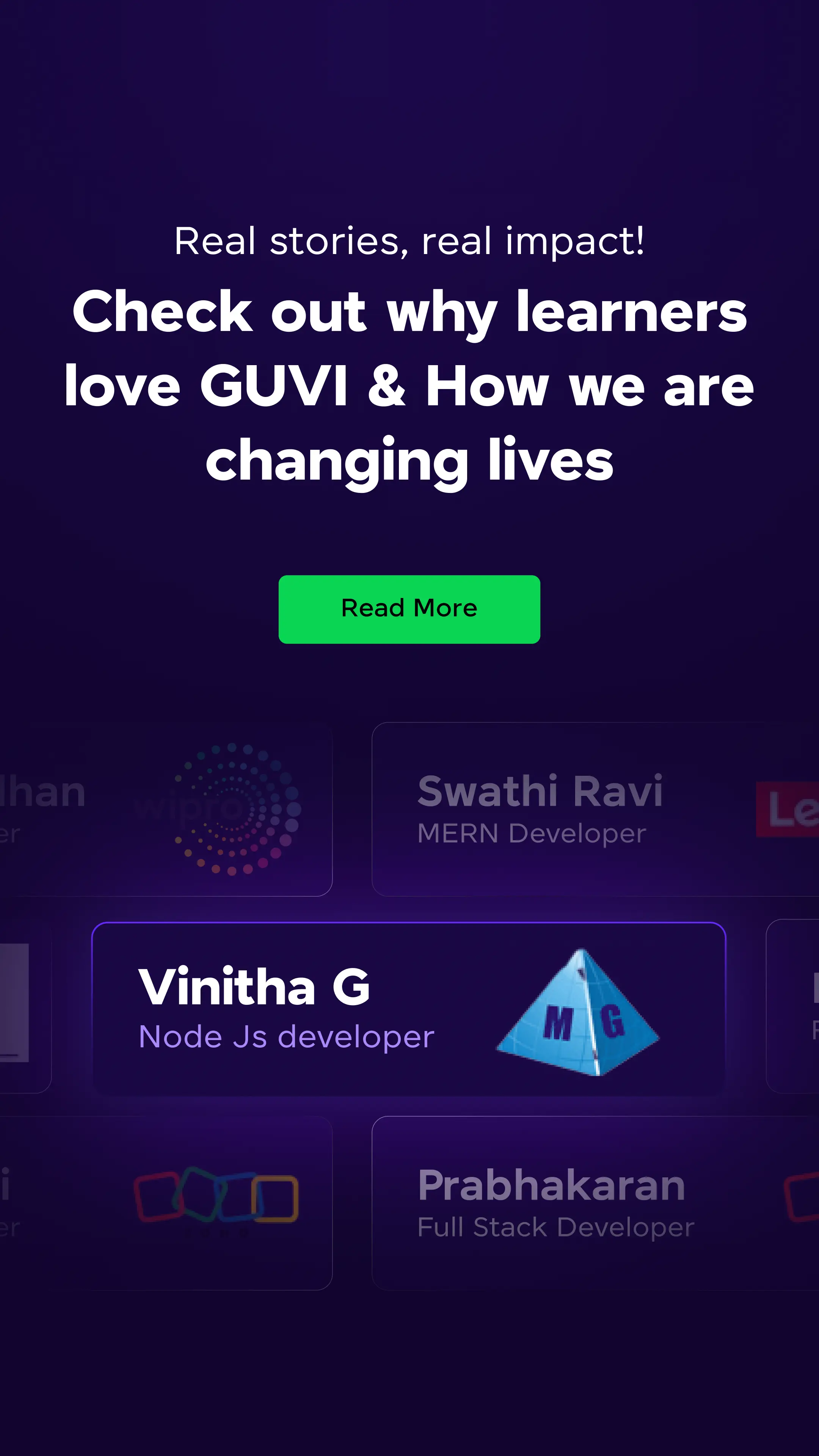















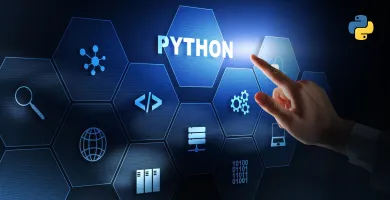



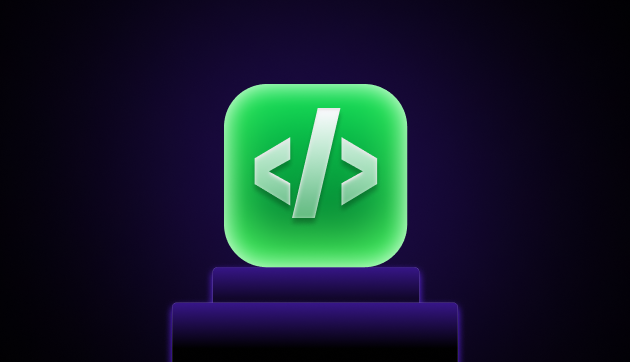
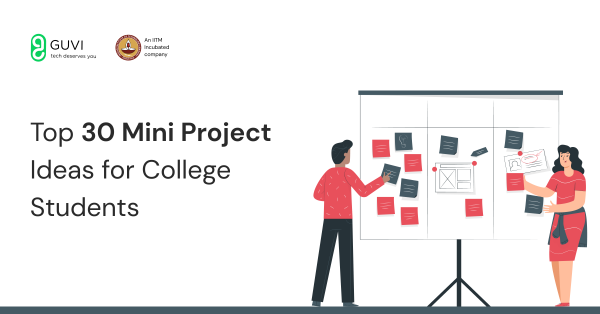

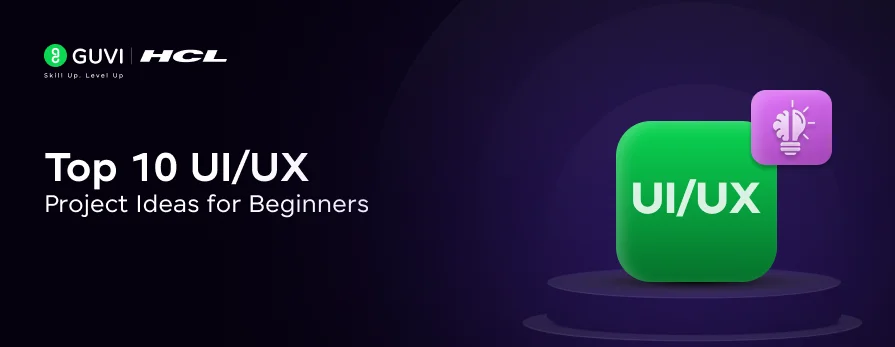


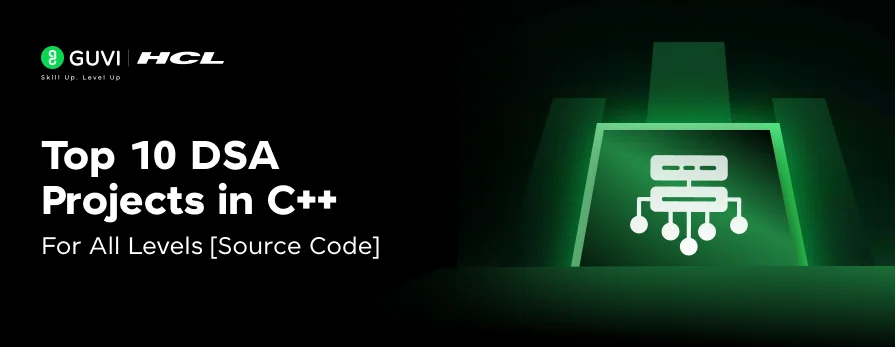

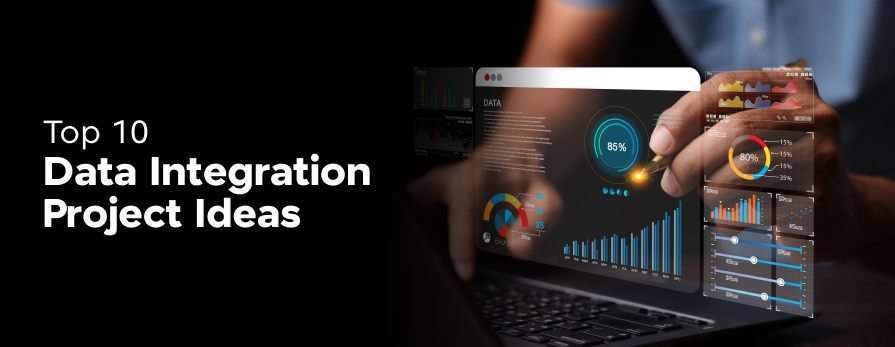




Did you enjoy this article?